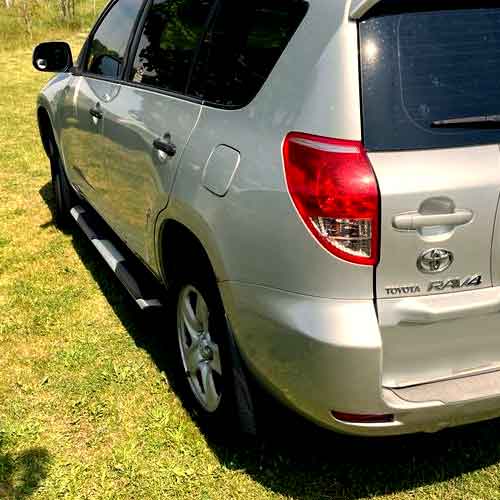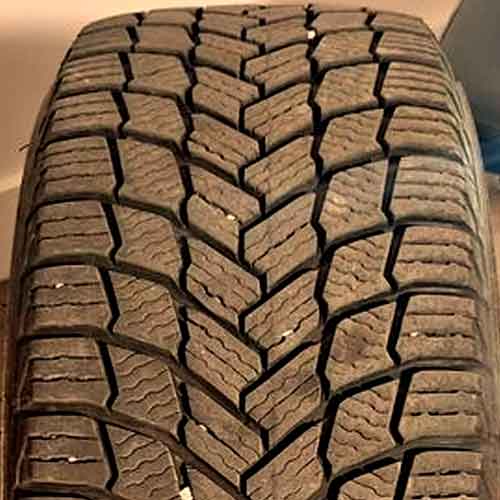The Michelin X-Ice Snow is the latest offering in the realm of studless ice & snow winter tires, where it’s designed for coupes, sedans, minivans, and crossovers. This tire is one of the best when it comes to snow performance. But what else does it have to offer? Let’s find out!

So overall the key takeaway is this: The Michelin X-Ice Snow tire provides commendable performance in various conditions, notably excelling in icy grip, snow handling, wet terrain water dispersion, road shock absorption, and tread longevity. While its strengths are many, there’s room for enhancement in noise reduction, dry road steering responsiveness, and fuel efficiency.
Info on Sizes: The Michelin X-Ice Snow comes in 125 total sizes in 15 to 22 inches. They have following specs.
- Speed ratings: T and H.
- Load ratings: SL and XL.
- Tread depth: 10.5/32″ on all.
- Weight: 16 to 40 lbs.
- Tread warranty: 40k miles.
Since the tire is one of best in terms of snow traction, I added it to my list of top studless winter tires.
Table of Contents
Tread Design
The Michelin X-Ice Snow offers a unique, directional tread pattern.

Now although its directional, it doesn’t have what they call, “swooping” lugs, as they are pretty voided up, longitudinally.
This basically divides the tread in to 6 block columns, with the outer two being shoulders.
These (shoulder) blocks have thick lateral slits, and are highlighted by the jagged edges on the sides.
In the middle most area of the tread, there’s a very biting zigzag circumferential groove, courtesy of interlocking blocks on both sides.
These lugs offer a lot of biting edges, (off-set and chamfered).
Moreover, they offer multi-directional siping.
The adjacent ribs also have similar tread features, but again sipes vary here as well, in terms of their angles/orientations.
Dry Performance
Even in winter tires, dry traction remains a cornerstone, focusing on rubber-road contact. This can be divided into lateral traction, and longitudinal grip.
Let’s start with later.
Dry Longitudinal Grip
This grip evaluates a tire’s linear traction, predominantly determined by the central tread’s road engagement, and measured by tire’s braking efficiency/efficacy.
(And if you’re wondering why central, you should know that this area of the tread gets the most weight concentration during straight-line movement).
Now, Michelin X-Ice Snow offers a pretty good job here, where it only lacks to the best tire here by only 3 feet (on average), when it comes to braking tests, I performed (from 40 mph).
Dry Handling
Comprehensive dry handling combines, both lateral traction with the tire’s steering responsiveness.
Now here, lateral traction of a tire hinges on its shoulder design, while steering depends on flexing of the lugs.
That’s why although Michelin X-Ice Snow although offers pretty decent overall traction values (compared to other winter tires in its category), it’s overall handling times aren’t that great, with its lagging steering response.
The tire although offers good enough braking and acceleration, its mid-cornering feedback is a little vague, where you don’t get the clear idea of how much traction is there.
So you get a little over-steering prone handling with this tire.
Overall Winter Performance
The efficacy of a tire in winter conditions hinges on its aptitude across two primary terrains, namely ice and snow.
Ice Traction
This traction underscores a tire’s capacity to cling to and navigate (relatively more) slippery ice terrains.
Given that icy roads are inherently slick and lack ample natural friction, the rubber composition and well made tread designs are highly needed here.
Meaning, optimal tires in this context should have numerous biters and retain their flexibility (as things get extreme cold).
Now talking about top-tier winter tires here, the Michelin X-Ice Snow is one of the highest ranking ones on ice.
And its superb performance can be attributed to a distinctive tread pattern that integrates multi-directional snow vices and well engineered angled incisions.
Basically all its ribs have unique siping pattern, where they vary in widths and angle orientations.
When this sophisticated aggressive siping strategy allow for grip in all directions. And as a result, you get notable braking distances and handling precision, (basically above average overall performance).
Snow Traction
Snow traction relates to the tire’s ability on snow-laden roads, (where there’s soft, salt-like snow). Here tires need to offer good enough ability to penetrate, grip, and subsequently shed snow particles.
This allows for snow-to-snow contact, which is pretty important as snowflakes’ distinct interlocking structures create more friction here, compared to rubber to snow contact.
Now this terrain is the expertise of Michelin X-Ice Snow tire, as it offers one of the best performance values, especially in terms of acceleration and handling.
The tire, coming with a directional pattern provides efficient snow scooping abilities (pushing it backwards), generating forward momentum and accleration.
While it’s 6 ribs, forming in-groove notches everywhere, allow for efficient snow-to-snow contact, resulting in best overall snow handling.
To give you an idea, the tire offers quickest snow laps (on tests), where it’s 2 seconds faster (on average), compared to Blizzak WS90, (review this tire here), which comes in the second quickest place here.
Wet Traction
The wet performance of a tire is dictated by its tread blueprint and rubber blend, influencing its wet grip and resistance to hydroplaning.
Wet Gripping
Wet grip revolves around the tire’s rubber-road contact in moist conditions, but as the intervening of water disrupts that (direct tread contact), how well tire disperses off water is the most crucial point here.
And this is achieved by the strategic interplay of grooves and sipes.
While grooves handle bulk water displacement to counter hydroplaning, sipes work at a micro-level, utilizing their inherent air expulsion to induce a suction effect, facilitating better ground contact.
Having said that, it makes sense why the X Ice Snow does pretty great here, offering a mixture of varying sipes (I talked about in the ice traction), and it’s weight (which basically helps hydroplaning, explained in the next section).
To give you a rough idea about its performance, the best tire in this (wet performance) category is the Continental VikingContact 7 (review), and in comparison, the Michelin X Ice Snow only lacks half a second, on average, in handling lap time tests.
Resistance to Hydroplaning
Hydroplaning emerges when water intrudes between the tire and the road, a result of water’s incompressibility. To combat this, tires are equipped with grooves to channel out water, staving off hydroplaning.
And since Michelin here throws out water very effectively, it puts less burden on sipes to begin with, improving its overall wet performance further.
So what’s helping the tire here?
Well, it offers 5 (tough-passing) longitudinal/circumferential channels, which are also interconnected with each other as well, thanks to the tire’s directional pattern.
This pattern of multi-angled grooves, offer water clear paths to run off and out of the tread in all directions, where the tire’s weight (being relatively greater), puts more pressure on lugs and water, so its pushed out with greater force.
The result: You get one of the best tire in terms of aquaplaning resistance.
Side Note: If you’re looking for a winter tire for your SUV, consider Bridgestone Blizzak DM-V2 (review), the tire offers top notch hydroplaning resistance.
Tread Longevity
Tread longevity intertwines with the dual concepts of rolling resistance and tread depth.
Where rolling resistance depends on tire’s weight, and tread’s composition.
Now looking at all these factors, it can be seen why the Michelin X-Ice Snow pretty decent overall tread life.
Now, even though the tire weighs a lot (relatively speaking), it’s Flex-Ice tread compound and technology still resist wear, as it allows for that weight to be distributed more evenly among its lugs.
Moreover, the tire’s tread rigidity, combined with tread depth that goes up to 10.5/32″ also help here, allowing for above-average overall tread longevity.
And that’s backed by it’s 40k miles treadwear warranty, (which is pretty significant, as almost 90% of the winter tires don’t provide you with any).
Comfort Levels
A tire’s comfort defines elements like road noise suppression and shock absorption, for the most part. And both of these are influenced by factors such as tire’s structure, material composition, tread design, and sidewall architecture, to name the most important one.
Let’s start with noise.
Tread Noise
Now tread noise primarily stems from air molecules colliding with tire treads. Meaning, if a tire has an expansive tread gaps, it’s more prone to elevated noise generation, unless its saved by other factors which include tread pattern and composition.
Now, the Michelin X Ice Snow does okay here, nothing fancy. I mean its good enough for a winter tire.
It’s shoulder voids are basically more open and allow for slightly more air to come in, and that combined with it’s multi-angled siping, you hear slightly more growling sounds.
Though it’s performance is still above average here, mainly thanks to its Piano Acoustic Tuning (a name Michelin gives to variable pitch producing tread, which keeps in-groove resonance low).
Bumps Absorption
Tires act as suspension system for vehicles, cushioning against road discrepancies through both their internal and external configurations.
And in this regard, the Michelin X-Ice Snow is one of the best.
This is mainly because of the tire’s thicker/more-absorbing internal construction, followed by it’s thick tread with independent lugs.
By independent lugs, I mean, all blocks aren’t restricted to flex around, soaking up the bumps potential energy in to kinetic.
Fuel Economy
Fuel economy in tires correlates with their mass and traction. Specifically, a denser tire with prominent tread gaps undergoes pronounced lug flexing during activities, consuming energy which otherwise would be directed to rolling, instead of reshaping lugs or heat production.
Now, the X-Ice Snow although offers a good enough rolling resistance here. It’s overall fuel economy is not so impressive, relatively.
And it makes sense since the tire carries a lot of weight, and has independent lugs, missing foundational supports. Moreover, with a lot of in-groove notches and multi-angled biters, the tire generates a lot of grip, translating in to greater fuel consumption compared to other tires.
So overall, the Michelin tire offers a fuel economy, which is slightly below average among other top ranking winter tires.
Conclusion
So overall, the Michelin X-Ice Snow tire exhibits pretty decent performance across varied conditions. Let me break it down for you in an easier manner.
So the tire excels when it comes to:
- Superior grip on icy terrains due to its unique tread pattern.
- Quick acceleration and impeccable handling on snow-covered roads.
- Efficient water dispersion on wet terrains, reducing hydroplaning risks.
- Effective absorption of road inconsistencies, ensuring a smoother ride.
- Above-average lifespan, bolstered by its Flex-Ice tread compound and supported by a significant treadwear warranty.
While its performance can be improved in:
- Noise reduction, as it offers only average suppression of road noise.
- Steering response on dry roads, which is marginally slower.
- Fuel economy, which is slightly below average when compared to other top-tier winter tires.